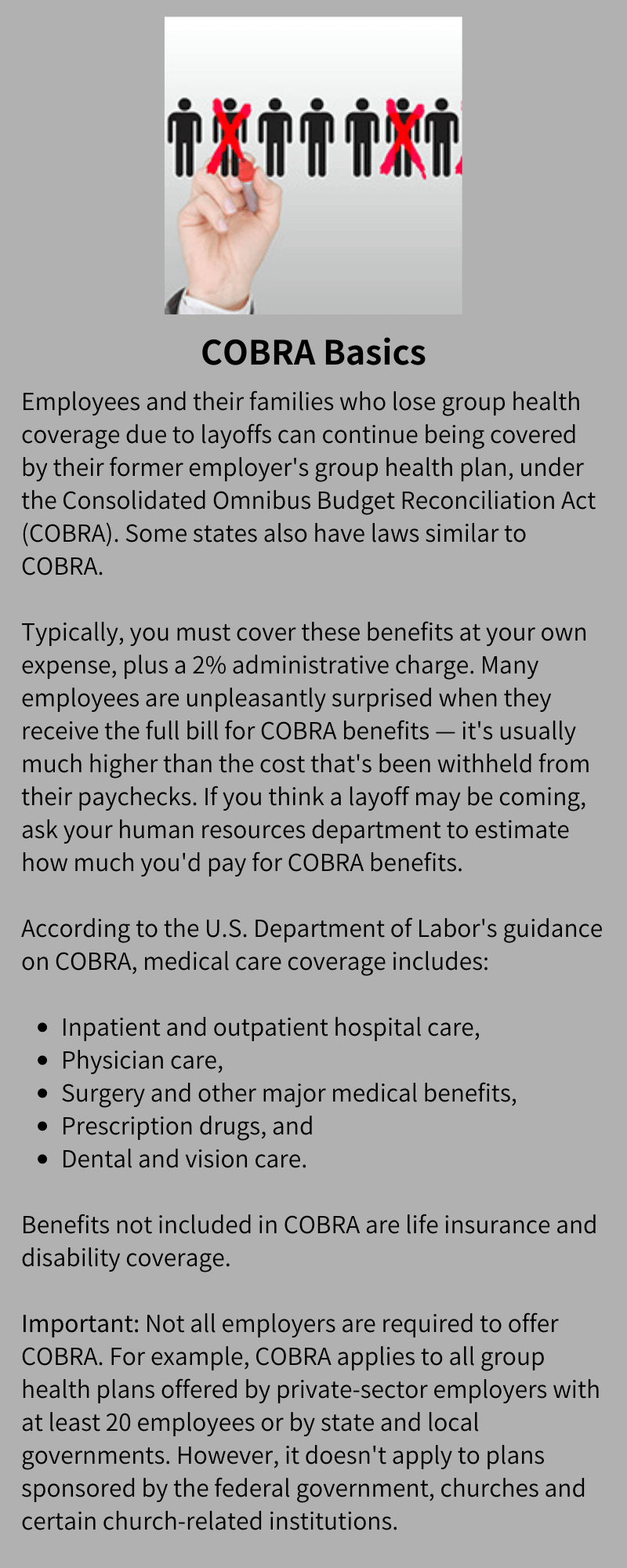
5 Tips to Help Prepare For a Possible Layoff
By Mueller Financial Services, March 14, 2023
The threat of a recession has persisted for over a year. With this uncertainty, many businesses may be considering layoffs. If you’re seeing clues that your employer might slash jobs and you’re worried about being on the firing line, it’s smart to prepare. Here are five personal finance tips you can use … just in case.
1. Increase Savings
In general, you should have enough savings to cover six to 12 months’ worth of essential monthly expenses. If that sounds unrealistic in your situation, scale back your savings to two to three months of expenses to establish some level of financial security. It can also help you avoid falling deeper into debt.
The easiest way to build emergency savings is to curtail spending before you’re laid off. Areas of nonessential costs include:
- Dining out,
- Buying gifts, and
- Outsourcing services that you can do yourself, such as housecleaning and yardwork.
You also might delay plans for buying a new vehicle, upgrading electronics or replacing worn furniture. Consider temporarily halting or decreasing contributions to your employer-based retirement plan. However, think this decision through carefully, particularly if your employer matches contributions. If you’re uncertain about this step, ask your financial advisor to run the numbers for you.
2. Weave a Safety Net
Have you requested an extension on your credit card limit? Do you have more than one credit card? Do you have access to a home equity line of credit? It’s important to apply for backup sources of credit in case your savings run out. The purpose isn’t to run up debt, but to have avenues in place that you can use to cover essential and unexpected expenses.
The best time to apply for a home equity line of credit or additional credit cards is while you have verifiable income — and while you aren’t in a rush. The faster you need credit, the less time you’ll have to shop around for lower interest rates.
3. Pay Down Existing Debt
It’s difficult, but not impossible, to accelerate payments on your current debts while building an emergency fund. To help achieve both objectives, consider picking up a side hustle, such as driving for a ride-share company. Dedicate that income toward paying off a car loan or credit card bills. Then the income from your day job, while it lasts, can be used to pay monthly expenses and bolster your rainy-day fund.
If you’re under the weight of student loan debts, you probably know that the Biden administration’s plan for federal student loan forgiveness has hit legal headwinds. If the plan is ultimately approved, it could wipe out $10,000 in federal student loan debt for individuals making less than $125,000 annually ($250,000 per year if you’re married). However, legal challenges are rarely resolved quickly.
In February 2023, the U.S. Supreme Court will examine whether the loan forgiveness plan is constitutional. For now, the Biden administration has extended a pause in student loan repayment into 2023, pending the Supreme Court decision. This gives current loan holders a temporary reprieve. If you’re facing a possible layoff, you may want to wait to make payments.
If you’re laid off, you may be able to defer student loan payments further. Your lender also might allow you to restructure any car or mortgage loans.
4. Use Existing Insurance and Other Employee Benefits Now
While still employed, take advantage of any employer-provided insurance benefits. Make important doctor and dental appointments. The copays you’ll have are likely to be lower than paying for these appointments without health insurance coverage.
You could use COBRA benefits that allow you to stay on your former employer’s insurance. (See “COBRA Basics” below) However, your cost is usually higher than the cost of coverage through your employer.

Review other employer-provided benefits, such as dependent or health care flexible spending accounts (FSA). Do you have unclaimed funds in those accounts? File now for reimbursement of any existing expenses. Also, contact your employer’s benefits program administrators to determine the deadlines for FSA reimbursements after you’re laid off.
5. Inquire about 401(k) Loans
Under current tax law, you have until the due date of your tax return to pay back a 401(k) loan taken from your employer’s plan. Before the Tax Cuts and Jobs Act, you had to pay it back within 60 days of being laid off.
If you don’t pay back a 401(k) loan within the required time frame, you must pay taxes on the difference between your outstanding balance and any nondeductible contributions. Usually, an early withdrawal penalty also applies if you’re under age 59½.
Keep in Mind that Unemployment Compensation Is Taxable
If you receive unemployment benefits, you generally must include the payments in your income when you file your federal income tax return. You should receive Form 1099-G, “Certain Government Payments,” showing the amount of unemployment compensation paid to you during the year. (Most states also tax unemployment benefits but five states don’t.)
Softening the Blow
Losing a job can be challenging and stressful. Having a plan to mitigate the adverse effects will help you stay afloat while looking for another opportunity. For more advice on preparing for and managing a layoff, call your financial advisor. He or she can help you cut expenses, apply for credit, renegotiate loans, navigate COBRA benefits and more.
Copyright © 2023
Financial PlanningRelated Insights

May 23, 2023
Secure 2.0: Advantages for Women
ShareJoin Susan Garbarino, Principal / Wealth Advisor, and Veronica Roshek, Wealth Advisor, as they discuss the advantages of the Secure …
Read More navigate_next